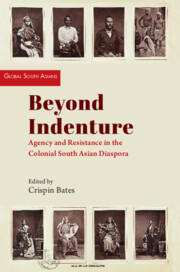Book contents
- Frontmatter
- Dedication
- Contents
- List of Figures and Tables
- Acknowledgements
- Introduction
- I Agency and Resistance
- 1 Negotiating Power in Colonial Natal: Indentured Migrants in Natal, 1860–1911
- 2 Stewed Plums, Baked Porridge and Flavoured Tea: Poisoning by Indian Domestic Servants in Colonial Natal
- 3 Labour Resistance in Indenture Plantations in the Assam Valley
- 4 A Forgotten Narrative of the Satyagraha Campaign: The Treatment of Prisoners between 1907 and 1914
- 5 Toilers across the Seas: Racial Discrimination and Political Assertion among Sikhs in Canada
- II Remigration
- 6 The Remigration of Hindostanis from Surinam to India, 1878–1921
- 7 Not So Anchored: The Remigration of Indians within the Caribbean Region
- 8 On the Move: Remigration in the Indian Ocean, 1850–1906
- III Gender and Family
- 9 Intimate Lives on Rubber Plantations: The Textures of Indian Coolie Relations in British Malaya
- 10 Labouring under the Law: Exploring the Agency of Indian Women under Indenture in Colonial Natal, 1860–1911
- 11 Gujarati ‘Passenger Indians’ in the Eastern Cape since 1900: Business, Mobility, Caste and Community
- 12 The Eurasian Female Workforce and Imperial Britain: Harnessing Domestic Labour by People of Mixed Racial Descent
- IV Legacies
- 13 After the Long March: Colonial-Era ‘Relief’ for Burma Indian Evacuees in Visakhapatnam District, 1942–1948
- 14 Opposing the Group Areas Act and Resisting Forced Displacement in Durban, South Africa
- 15 Indo-Fijians: From Agency to Abjection
- 16 New and Old Diasporas of South South Asia: Sri Lanka and Cyber-Nationalism in Malaysia
- About the Contributors
- Index
12 - The Eurasian Female Workforce and Imperial Britain: Harnessing Domestic Labour by People of Mixed Racial Descent
Published online by Cambridge University Press: 31 December 2023
- Frontmatter
- Dedication
- Contents
- List of Figures and Tables
- Acknowledgements
- Introduction
- I Agency and Resistance
- 1 Negotiating Power in Colonial Natal: Indentured Migrants in Natal, 1860–1911
- 2 Stewed Plums, Baked Porridge and Flavoured Tea: Poisoning by Indian Domestic Servants in Colonial Natal
- 3 Labour Resistance in Indenture Plantations in the Assam Valley
- 4 A Forgotten Narrative of the Satyagraha Campaign: The Treatment of Prisoners between 1907 and 1914
- 5 Toilers across the Seas: Racial Discrimination and Political Assertion among Sikhs in Canada
- II Remigration
- 6 The Remigration of Hindostanis from Surinam to India, 1878–1921
- 7 Not So Anchored: The Remigration of Indians within the Caribbean Region
- 8 On the Move: Remigration in the Indian Ocean, 1850–1906
- III Gender and Family
- 9 Intimate Lives on Rubber Plantations: The Textures of Indian Coolie Relations in British Malaya
- 10 Labouring under the Law: Exploring the Agency of Indian Women under Indenture in Colonial Natal, 1860–1911
- 11 Gujarati ‘Passenger Indians’ in the Eastern Cape since 1900: Business, Mobility, Caste and Community
- 12 The Eurasian Female Workforce and Imperial Britain: Harnessing Domestic Labour by People of Mixed Racial Descent
- IV Legacies
- 13 After the Long March: Colonial-Era ‘Relief’ for Burma Indian Evacuees in Visakhapatnam District, 1942–1948
- 14 Opposing the Group Areas Act and Resisting Forced Displacement in Durban, South Africa
- 15 Indo-Fijians: From Agency to Abjection
- 16 New and Old Diasporas of South South Asia: Sri Lanka and Cyber-Nationalism in Malaysia
- About the Contributors
- Index
Summary
The Invisibility of Eurasian Female Domestic Migrant Labourers in Britain
At the outset of this chapter, I would like to clarify that the term ‘Eurasian’ to identify ‘biracial’ people or people of mixed racial descent (Euro-Asian) was in general use throughout the Victorian Age. It was replaced by the term ‘Anglo- Indian’ in 1911, when members of the community in India made it known through their leaders that they would prefer to be labelled as such in order to distinguish them from the mixed-race offspring of colonials based in other parts of Asia and the Far East. After India’s Independence in 1947, the community was more categorically defined in Article 366(2) of the Constitution of India as the progeny of European fathers and Indian mothers domiciled in India (then British India, now among the territories of India, Pakistan and Bangladesh). The perplexing issue of their nomenclature attains significance for the simple reason that they were often erroneously classified: as ‘Europeans’ when in India and as ‘Indians’ or ‘Asiatics’ when outside the colony. Rarely were they correctly labelled as ‘Eurasians’ or ‘Anglo-Indians’ – a matter that makes it challenging to isolate them as a distinct ethnic community among Indians and has added to their invisibility. Indeed, as much as India’s people of mixed racial descent are ‘invisible’ in the South Asian diaspora as immigrants in Great Britain today, so too had they remained uncounted among labour forces in England during the decades of the British Raj. The reasons for their ‘invisibility’ (as I have argued in my book on Britain’s Anglo-Indians2) are that they had European surnames (either Portuguese, French, Dutch or British, derived from their paternity) and anglicised first names, were 100 per cent Christian by religious affiliation, were either Roman Catholic or Anglican, and employed English as their mother tongue. They were also westernised in terms of dress and lifestyle. This combination of factors served to create the identity confusion that still plagues the community but also serves to single them out in photographs when depicted in diverse groups.
Difficult as it might be to identify people of mixed racial descent from the Indian subcontinent in the United Kingdom (UK) today, it is well-nigh impossible to ascertain their presence in the UK during the colonial era.
- Type
- Chapter
- Information
- Beyond IndentureAgency and Resistance in the Colonial South Asian Diaspora, pp. 262 - 292Publisher: Cambridge University PressPrint publication year: 2024



